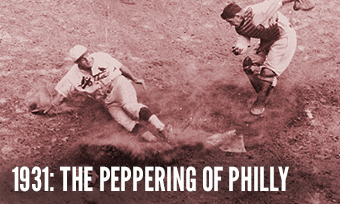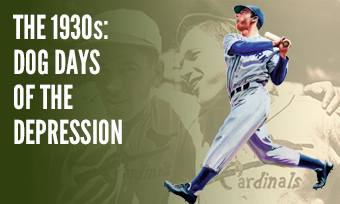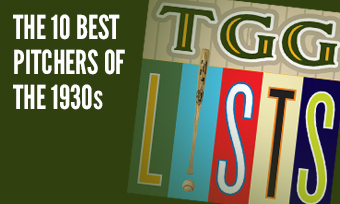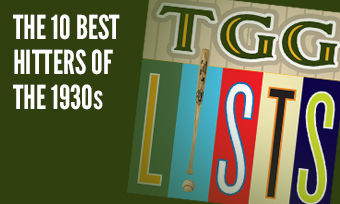The Yearly Reader
Leaders and Honors, 1931
Our list of baseball’s top 10 hitters and pitchers in both the American League and National League for the 1931 baseball season, as well as the awards and honors given to the game’s top achievers of the year.
The National League’s Top 10 Hitters, 1931
Bold type in brick red indicates league leader.
1. Chuck Klein, Philadelphia
Key Numbers: .337 average, 121 runs, 200 hits, 34 doubles, 10 triples, 31 home runs, 121 RBIs, .584 slugging percentage.
No one continued to embrace Philadelphia’s Baker Bowl more than Klein, who hit over .400 there for the second straight year. (He hit just .269 on the road.)
2. Bill Terry, New York
Key Numbers: .349 average, 121 runs, 213 hits, 43 doubles, 20 triples, 9 home runs, 112 RBIs.
Terry’s league-leading dose of triples included four games with multiple three-baggers.
3. Chick Hafey, St. Louis
Key Numbers: .349 average, 94 runs, 35 doubles, 8 triples, 16 home runs, 95 RBIs, .404 on-base percentage.
Hafey thanked the optometrist and became the first bespectacled batting champ; a year later, he found himself in Cincinnati after being embroiled in a salary dispute with the Cardinals.
4. Mel Ott, New York
Key Numbers: .292 average, 104 runs, 23 doubles, 8 triples, 29 home runs, 115 RBIs, 80 walks.
Ott quietly hit his 100th career home run at age 22.
5. Babe Herman, Brooklyn
Key Numbers: .313 average, 93 runs, 191 hits, 43 doubles, 16 triples, 18 home runs, 97 RBIs, 17 stolen bases.
Herman became the first player to hit for the cycle twice in one season; no one would do that again until Aaron Hill in 2012.
6. Kiki Cuyler, Chicago
Key Numbers: .330 average, 110 runs, 202 hits, 37 doubles, 12 triples, 9 home runs, 88 RBIs, 72 walks, 13 stolen bases, 17 caught stealing.
Kiki continued to hit like the wind, but his velocity on the basepaths started to slow—Stealing only 13 of 30 attempted bases after being successful 84% of the time over the previous four years.
7. Wally Berger, Boston
Key Numbers: 156 games, .323 average, 94 runs, 199 hits, 44 doubles, 8 triples, 19 home runs, 84 RBIs, 13 stolen bases.
In what would be a standard state of affairs for much of the 1930s, Berger collected more home runs (19) than the rest of his teammates combined (15).
8. Rogers Hornsby, Chicago
Key Numbers: 100 games, .331 average, 37 doubles, 16 home runs, 90 RBIs, 56 walks.
At age 35, Hornsby gave it one last solid ride as a hitter; in fact, he set career marks on April 24 with three home runs and eight RBIs—at Pittsburgh’s spacious Forbes Field, of all places.
9. Woody English, Chicago
Key Numbers: 156 games, .319 average, 117 runs, 202 hits, 38 doubles, 8 triples, 68 walks, 12 stolen bases.
Along with Kiki Cuyler, English provided sparkplug energy for the Cubs’ offense.
10. Buzz Arlett, Philadelphia
Key Numbers: 121 games, .313 average, 26 doubles, 7 triples, 18 home runs, 72 RBIs.
The curious case of Arlett, who played his one and only season in the majors—sandwiched between 19 minor league years and 432 home runs. Reason he was gone by 1932? He wanted to go back to the minors.
The American League’s Top 10 Hitters, 1931
1. Babe Ruth, New York
Key Numbers: .373 average, 149 runs, 199 hits, 31 doubles, 46 home runs, 162 RBIs, 128 walks, .495 on-base percentage, .700 slugging percentage.
Ruth tied Gehrig for what would be his last ranking at the top of the AL home run chart; he paired with the Iron Horse to set a major league record for most RBIs (347) by a pair of teammates in one season.
2. Lou Gehrig, New York
Key Numbers: 155 games, .341 average, 163 runs, 211 hits, 31 doubles, 15 triples, 46 home runs, 185 RBIs, 117 walks, 17 stolen bases.
For many years, Gehrig’s RBI total actually sat at 184, but sabermetric clean-up in the Retrosheet era discovered that he should have had one more—thus giving him the sole AL record and demoting Hank Greenberg (who also knocked in 184, in 1937) to second.
3. Al Simmons, Philadelphia
Key Numbers: .390 average, 105 runs, 200 hits, 37 doubles, 13 triples, 22 home runs, 128 RBIs.
Simmons finished above .360 for the third straight year; no one would do that again until Larry Walker (1997-99).
4. Earl Averill, Cleveland
Key Numbers: .333 average, 627 at-bats, 140 runs, 209 hits, 36 doubles, 10 triples, 32 home runs, 143 RBIs, 68 walks.
Averill was one of the few hitters whose stats actually improved over 1930, setting career highs in runs, home runs and RBIs.
5. Ben Chapman, New York
Key Numbers: .315 average, 120 runs, 189 hits, 28 doubles, 11 triples, 17 home runs, 122 RBIs, 75 walks, 61 stolen bases, 23 caught stealing.
The guy who would later make for notoriety as the Phillies manager who taunted Jackie Robinson was, for now, the guy who stole the most bases in a season between 1920 and 1943.
6. Goose Goslin, St. Louis
Key Numbers: .328 average, 114 runs, 194 hits, 42 doubles, 10 triples, 24 home runs, 105 RBIs, 80 walks.
Goslin was on his way to matching his highest career batting average (.379 in 1928) before slumping off in the season’s final two-plus months.
7. Jimmie Foxx, Philadelphia
Key Numbers: .291 average, 93 runs, 32 doubles, 10 triples, 30 home runs, 120 RBIs, 73 walks, 84 strikeouts.
Although still potent enough to make this list, Foxx struggled with knee, foot and sinus issues that brought him below .300 for the only time throughout his first 12 seasons.
8. Joe Cronin, Washington
Key Numbers: 156 games, .306 average, 103 runs, 187 hits, 44 doubles, 13 triples, 12 home runs, 126 RBIs, 81 walks.
With Goslin now firmly entrenched in St. Louis, Cronin became the de facto home run leader for the Senators—and of course, most of them were hit away from expansive Griffith Stadium.
9. Earl Webb, Boston
Key Numbers: .333 average, 96 runs, 196 hits, 67 doubles, 14 home runs, 103 RBIs, 70 walks.
Webb’s doubly good hitting theatrics helped the Red Sox end their six-year run in the AL cellar.
10. Mickey Cochrane, Philadelphia
Key Numbers: 122 games, .349 average, 87 runs, 31 doubles, 6 triples, 17 home runs, 89 RBIs.
Not to take anything away from the Hall-of-Fame catcher, but no one’s going to complain about batting in front of Al Simmons and Jimmie Foxx.
The National League’s Top 10 Pitchers, 1931
1. Bill Walker, New York
Key Numbers: 2.26 ERA, 16 wins 9 losses, 37 appearances, 28 starts, 6 shutouts, 239.1 innings.
Known qualities in Carl Hubbell and Freddie Fitzsimmons were overshadowed by the relatively unknown Walker, who captured his second NL ERA title in three years.
2. Heinie Meine, Pittsburgh
Key Numbers: 2.98 ERA, 19 wins, 13 losses, 36 appearances, 35 starts, 22 complete games, 284 innings.
In a year where the NL had no 20-game winners for the first time ever, among those who came closest was Heinie Meine—a junkballer whose career appeared doomed 10 years earlier when his bread-and-butter spitball was declared toast by the majors.
3. Freddie Fitzsimmons, New York
Key Numbers: 3.05 ERA, 18 wins, 11 losses, 253.2 innings, 62 walks.
Some would say Fitzsimmons was lucky to gather up 18 wins because his team averaged nearly six runs per start—but with four home runs and 18 RBIs over 92 at-bats, he had a little something to do with it.
4. Carl Hubbell, New York
Key Numbers: 2.65 ERA, 14 wins, 12 losses, 21 complete games, 248 innings, 155 strikeouts.
About the only thing the screwball master had yet to actually master was run support from his teammates—how else would one explain a 13-12 record to go with the NL’s second-best ERA behind teammate Walker?
5. Ed Brandt, Boston
Key Numbers: 2.92 ERA, 18 wins, 11 losses, 23 complete games, 250 innings.
Brandt turned a 21-45 record over his three previous years into something completely different, thanks to an 8-0 start.
6. Bill Hallahan, St. Louis
Key Numbers: 3.29 ERA, 19 wins, 9 losses, .679 win percentage, 37 appearances, 30 starts, 248.2 innings, 159 strikeouts, 112 walks, 11 wild pitches.
They didn’t call him Wild Bill for nothing—and by leading the NL in strikeouts, walks and hit batsmen, he was seldom wilder.
7. Tom Zachary, Boston
Key Numbers: 3.10 ERA, 11 wins, 15 losses, 33 appearances, 28 starts, 16 complete games, 229 innings.
The second-year Brave was abandoned by his teammates late in the season, averaging less than two runs per start over his last 12 assignments.
8. Charlie Root, Chicago
Key Numbers: 3.48 ERA, 17 wins, 14 losses, 39 appearances, 31 starts, 251 innings.
It was Root, Root, Root for the Cubbies at the Friendly Confines: The 32-year-old righty was 12-6 with a 2.35 ERA at Wrigley Field, 5-8 with a 5.15 mark on the road.
9. Watty Clark, Brooklyn
Key Numbers: 3.24 ERA, 14 wins, 10 loses, 233.1 innings, 52 walks.
Maybe it was the deadening of the ball over the 1930 model, but Clark reduced his home run allowed total from 20 to four.
10. Syl Johnson, St. Louis
Key Numbers: 3.00 ERA, 11 wins, 9 losses, 207.1 innings, 29 walks.
A common pitcher who managed to stick with the majors for 19 years—collecting four World Series rings along the way—Johnson was uncommonly good despite the common record; his .286 opposing on-base percentage was the NL’s third best.
The American League’s Top 10 Pitchers, 1931
1. Lefty Grove, Philadelphia
Key Numbers: 2.06 ERA, 31 wins, 4 losses, .886 win percentage, 41 appearances, 30 starts, 27 complete games, 4 shutouts, 288.2 innings, 175 strikeouts, 62 walks.
Grove became the only AL pitcher to win 30 games between 1920 and 1968.
2. Lefty Gomez, New York
Key Numbers: 2.67 ERA, 21 wins, 9 losses, .700 win percentage, 40 appearances, 26 starts, 243 innings.
The debut of Gomez on the major league stage was a thriving oasis in a temporary wasteland of bad Yankees pitching.
3. George Earnshaw, Philadelphia
Key Numbers: 3.20 ERA, 15 wins, 14 losses, 42 appearances, 32 starts, 258.2 innings.
Lefty Grove’s faithful sidekick in the A’s rotation continued to be one of the majors’ most generously supported pitchers—receiving over six runs of support per start.
4. Lloyd Brown, Washington
Key Numbers: 3.73 ERA, 15 wins, 11 losses, 42 appearances, 34 starts, 260.1 innings.
The Texan southpaw reached the peak of a career that would see him pitch past the age of 50 in the minors during the 1950s.
5. Firpo Marberry, Washington
Key Numbers: 3.45 ERA, 16 wins, 4 losses, .800 win percentage, 8 saves, 45 appearances, 25 starts.
Baseball’s first full-time reliever and now part-time starter, Marberry ran his three-year record to 50-21.
6. Bump Hadley, Washington
Key Numbers: 3.06 ERA, 11 wins, 10 losses, 7 saves, 55 appearances, 11 starts.
Though Marberry (barely) nailed down the team lead in saves, it was Hadley who spent most of the year as the chief closer (or finisher, as they might as well had called it back then), posting a 2.52 ERA coming out of the bullpen as opposed to a 4.59 mark when starting.
7. Wes Ferrell, Cleveland
Key Numbers: 3.75 ERA, 22 wins, 12 starts, 40 appearances, 35 starts, 27 complete games, 276.1 innings, 130 walks.
In year dominated by Grove, Ferrell stole honors for the game of the year, throwing his lone career no-hitter while pumping out one of his nine homers—a major league season record for pitchers.
8. Rube Walberg, Philadelphia
Key Numbers: 3.74 ERA, 20 wins, 12 losses, 44 appearances, 35 starts, 291 innings.
After admirably toiling in the shadows of Lefty Grove in Philadelphia, Walberg scored 20 wins for the first and only time in his career—and still finished 11 wins behind Grove.
9. George Uhle, Detroit
Key Numbers: 3.50 ERA, 11 wins, 12 losses.
The veteran right-hander and former Cleveland workhorse finished the year on a high, winning six of his last seven decisions just to get near the .500 mark.
10. General Crowder, Washington
Key Numbers: 3.88 ERA, 18 wins, 11 losses, 44 appearances, 26 starts.
Firmly back in Washington where he began his career in 1926, Crowder was just warming up for the productive peak of his career to follow in 1932-33.









